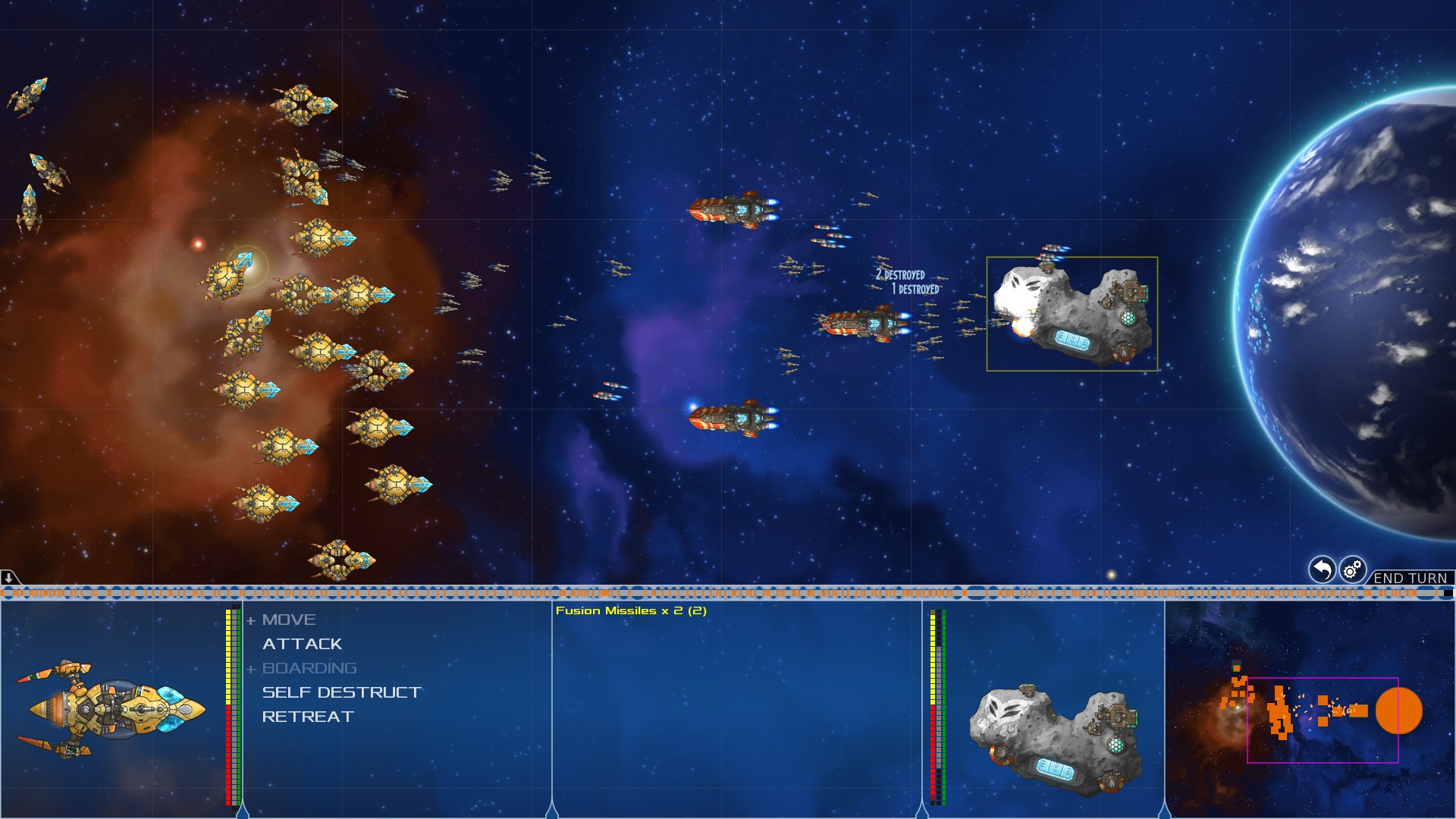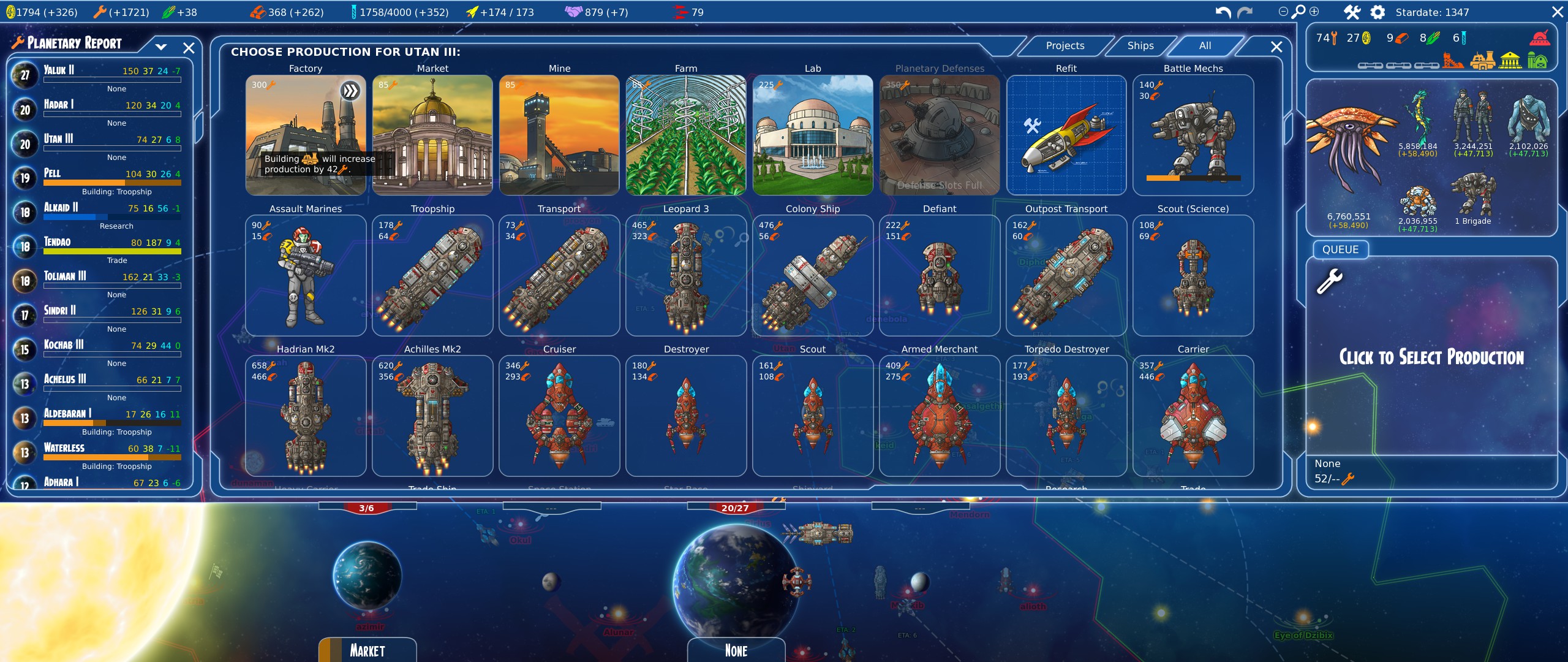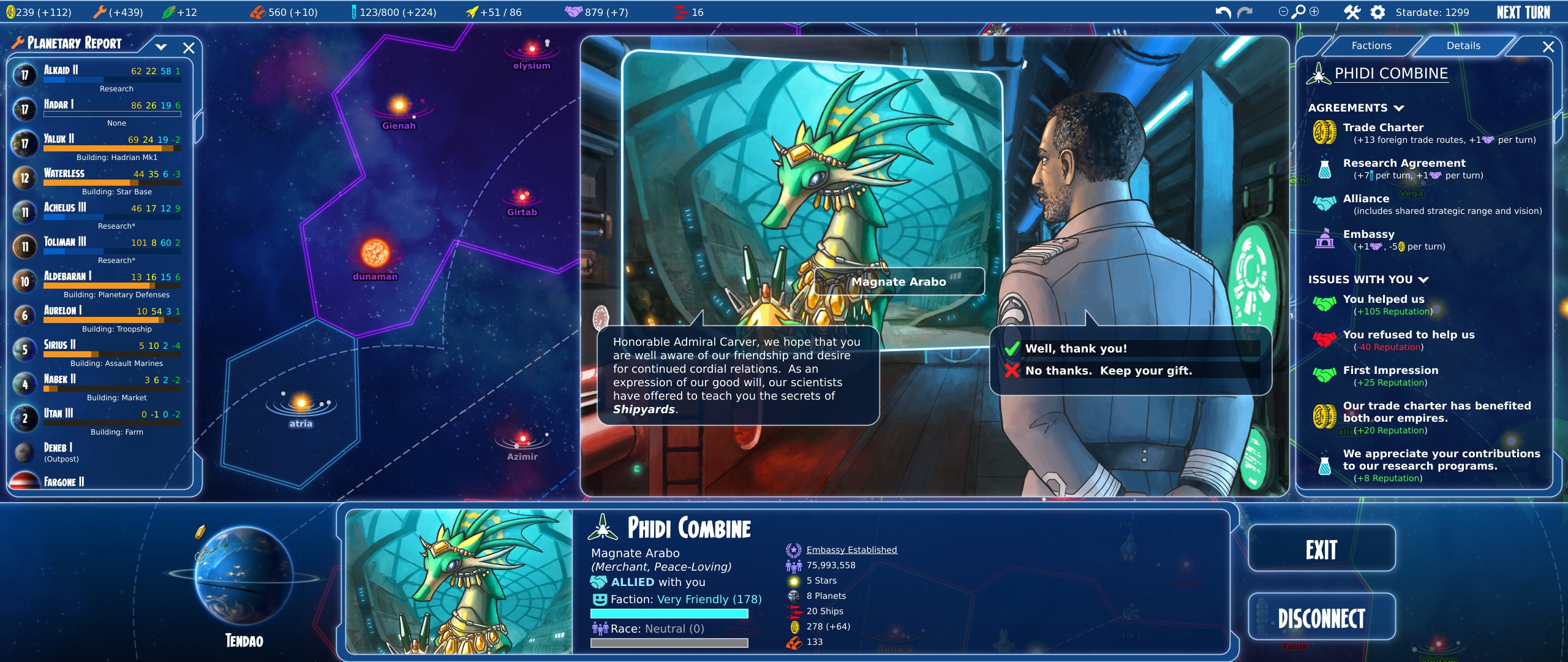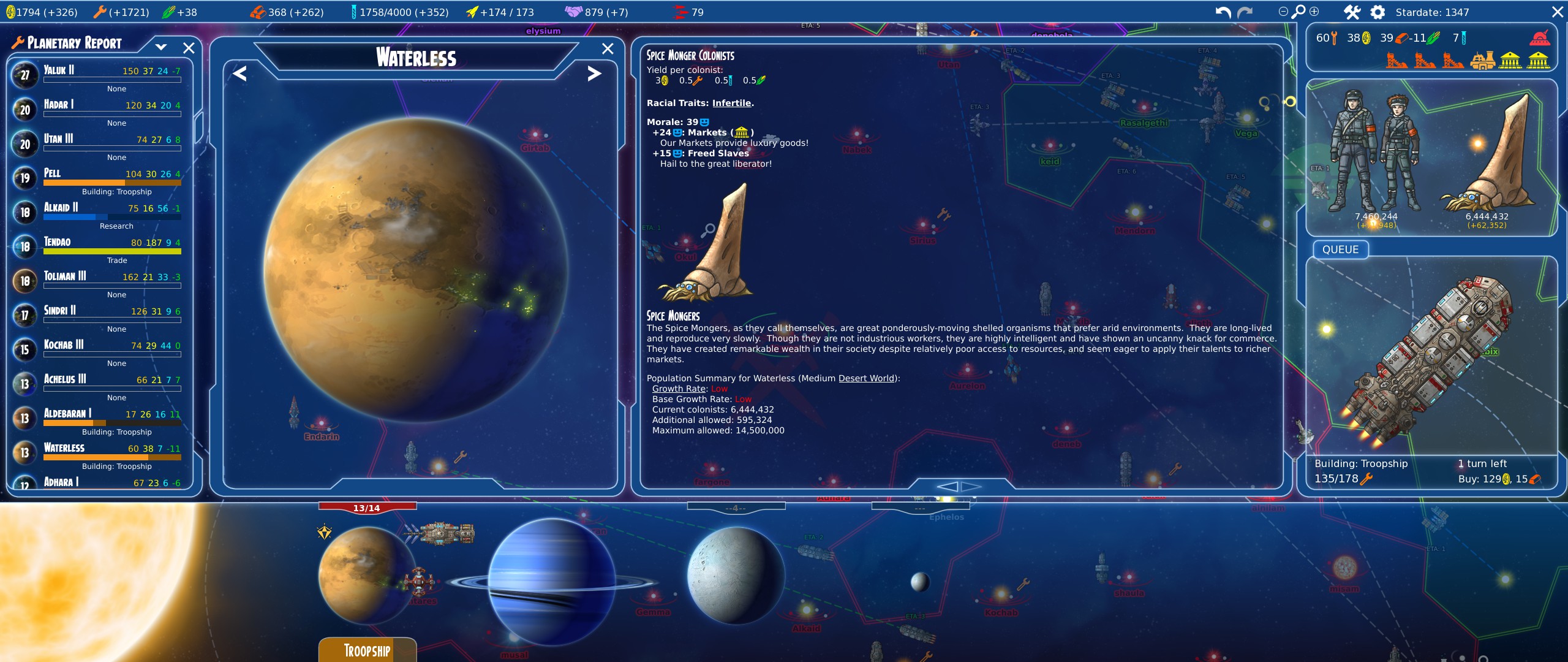- Stars in Shadow — a hidden indie 4X gem
- Stars in Shadow interview, with Sven Olsen and Jim “Arioch” Francis
I am very pleased to present an email interview with Jim “Arioch” Francis and Sven Olsen. Sven and Arioch are the creators of Stars in Shadow — a clever, elegant indie space 4X game. Read on to learn about their design philosophy, what makes good AI, a final tip about the game’s difficulty, and much more.
I’d like to begin by asking you about the origins of Stars in Shadow. What was the genesis of the project, and how long did you work on it?
Arioch: Sven first contacted me around 2008 about doing some concepts for a space game that he had in mind. Over the course of several years, the project continued and became gradually more and more serious. As a former programmer myself, I was dubious about the ability of a single programmer to tackle a project of this scope, but Sven proved my concerns wrong. The project progressed to a point where we got a Steam greenlight, and a publisher showed interest, and we released the game in 2017.
Sven: I played a lot of moo2 back in the 90’s and early 2000’s, and I always knew there were things I really liked about that gameplay experience, but also big areas I thought could be improved. I also started reading Arioch’s Outsider comic around the start of its run in 2002. As a fan of the comic, I quickly concluded that Arioch’s art style would be a perfect fit for the reworked moo2-like experience I wanted to create. I found myself with the time and money to start working seriously on the project in 2010, and fortunately Arioch was willing to help out.

I particularly liked three aspects of the game: its design philosophy, AI, and charm. The design’s simplicity and elegance stood out for me — a throwback to Sid Meier’s rule about “a game being a series of interesting decisions”. Can you tell us more about your philosophy?
Arioch: We started working before the recent glut of 4X space strategy games, and I think both Sven and I thought that the releases up to that point didn’t really scratch the same itch that our favorite games in the genre did — Master of Orion and Sword of the Stars. It seemed clear to us where the “fun” factor existed, and it was not in an expanding list of features, but rather in a focus on tactical combat. Once we were far enough into the project that the possibility of release became serious, there was suddenly a glut of new 3X space games. But they all had one thing in common: they completely ignored the tactical combat that we thought was so vital to the genre. Even our own publisher recommended that we discard our focus on tactical combat. Apparently this was the consensus at the time.
Sven: I think Civilization-style strategy games all suffer from an escalating micro-management problem. Choices that are fun and significant in the early game become tedious and needlessly time consuming by the late game. I wanted to try to design the game in such a way that that would be less true — and stripping the planet management component back to something more moo1-like, while keeping the tactical battle component relatively complex, seemed like a sensible route to doing that. Part of the design challenge for me was that I knew I didn’t want to go all the way to a moo1/SotS style highly abstract planet management system. In particular, I really enjoyed the species-specific population management element from moo2, and knew I wanted to build on and expand that idea. Getting a blend of all these elements that felt right took a long time. The initial drafts of the game that beta-testers had access to didn’t even include mines or farms or markets — planets just had factories and labs. Metal and food were relatively late additions to the game, but I felt like they were important ones. And I think we managed to implement them in a way that made planet management more interesting, without triggering as much of a late-game slog as you’d see in a more typical Civilization-style strategy experience.

Designing good AI in 4X games isn’t easy — it must navigate complex rules, offer the right challenge, and not break the player’s immersion. What can you tell us about your approach? And do you think simple design helps the AI?
Arioch: I think that immersion is less about complexity and more about whether game rules feel intuitive, or whether they feel artificial and “gamey.” I’m of the opinion that if you are clear in your objective, then the details seem to work themselves out. When possible, opt for choices that seem fun and reasonable, and which provide meaningful differences between the factions, and worry about balance and AI as a secondary concern. That’s easy for me to say, since I’ve never done any AI programming work, but I think that Sven has done a remarkable job especially in this regard. Though I think we’re both ready to admit that our testers helped out a lot here.
Sven: Yeah, one point that Arioch and I were very much in agreement on is that the role of the AI is not to be an artificial version of a human player. I always thought about the role of AIs as being closer to that of NPCs in a roleplaying game — they’re there to provide the player with allies and antagonists, and to make the world more immersive. There shouldn’t be any sense in which the AI emperors “know” that they’re playing a game — their choices and behaviors need to make sense in the context of the world, which is different than saying that they need to be in some sense “optimal” game players. That said, if the player can see that the AI is “doing something dumb” or if the AI is clearly playing by different rules than the player, then that breaks immersion. So even if the primary goal of the AI is not to be an artificial player, the AI still needs to have relatively sound tactical and strategic judgements — otherwise it’s less interesting to compete against. Like many of the game components, the AI went through a lot of revisions, both before and after release. The version you’re playing against in 2021 is very different than the simple AI that existed at beta, or the still relatively unpolished version that we launched with in 2017. And a lot of credit for that improvement goes to harpy_eagle — a modder who contributed some very interesting AI-improving mods, and then started working directly with me to integrate and further improve those mods as core game features.

I was charmed by the game’s worldbuilding, writing, and art style. Can you tell us more about how you chose and stayed consistent to this tone?
Arioch: Sven established the initial tone and some frameworks for the kind of factions he envisioned (fun and colorful), and we came up with the rest together. Worldbuilding is really my passion, and I think Sven really let me run with most of my ideas, but it was and is a shared creation.
Sven: When I initially approached Arioch, I was trying to recruit him primarily as an artist. But I knew he had great talent as a writer as well. We shared an enthusiasm for a lot of the same source material — in particular we both loved what Paul Reiche III did in Star Control II, and shared a lot of reference points in both American scifi and anime. Watching Arioch flesh out the world, and helping that process along, has been one of my favorite parts of the project.
How have you found the experience of being an indie space 4X developer? It looks competitive — there are a lot of others inspired by the classics.
Arioch: Aside from some trepidation before release when we saw how many major studios were releasing entries in what we had thought was a virtually abandoned genre, I’ve found it to be a good experience. I was afraid that most gamers would see us as “just another Master of Orion clone,” and there certainly have been those with that criticism, but I think the independent game development landscape is very open to small developers, especially those with a passion for their projects. I’m biased of course, but I still don’t think there have been any big-budget offerings in this genre that compare with MOO2, except perhaps Stellaris, but that sort of grand-strategy take is not my personal cup of tea.
Sven: Yeah, the market is competitive, but the player base has been great. We’ve gotten a lot of great feedback and productive participation from fans throughout the life of the project.
What’s your favourite thing about SiS? This could be a feature you’re especially proud of, or an “aha” moment during development.
Sven: The piece I’m probably the most personally proud of is the way population management and growth works. I knew I wanted habitat affinities for each species, so you could mix and match species on a given planet to take better advantage of the planet’s environment. Import seahorse people to make better use of your oceans, or lizard people to do better in deserts, and so on. But I fairly quickly realized that doing that in a way that would not 1) be very confusing for the player or 2) introduce a bunch of tedious micro or 3) be almost impossible to scale beyond 2 or 3 habit traits would be hard. I tried a bunch of different designs, before finally getting fairly deep into abstract math to come up with the system that’s actually in the game. If any future 4X designers were to go poking around in SiS looking for good ideas to steal, that would be the one I’d be most flattered to see borrowed. The code is all fairly well documented — and if you’re a math geek, you may find it fun to open up pop_growth.lua and give it a read :)

What is the status of the game & what are your future plans? I understand you’re working on an upcoming DLC.
Arioch: We have a second DLC in the works, though that is experiencing delays since we both have to work on other projects.
Sven: Yeah, what Arioch said :)
Do you have plans for other projects besides Stars in Shadow?
Arioch: My main project right now is my own webcomic (Outsider), but I’ve really enjoyed the challenges of game design.
Sven: I still see a lot of ways we can continue to improve on the gameplay experience in SiS. In the shorter team, we have plans for another expansion. In the longer term, it’s hard to say exactly where things may go.
Do you have any final message for the readers?
Sven: If you’re coming into the game fresh, you should know that the difficulty levels are tuned to be pretty difficult, even for players who know the game well. I wanted “Hard” to be hard enough that I, as the game’s main designer, would still find it fun and challenging to play. And I wanted “Brutal” to be about where I imagined moo2’s “Impossible” difficulty really should have been. Which is to say, not quite *technically* impossible in all cases, but certainly hard enough that if you eke out a win on Brutal map, it should feel like a significant accomplishment. As far as I can tell, most of our players do in fact play on “Normal”, and feel like the game is most fun at that setting.
Stars in Shadow is available for PC on Steam, GoG, and other storefronts.
Enjoying the site? Subscribe via email below.
Discover more from Matchsticks for my Eyes
Subscribe to get the latest posts sent to your email.
SiS is by far the best of the glut of space strategy games that came out recently. Great interview!
Glad you liked it, and thanks for putting the game on my radar!